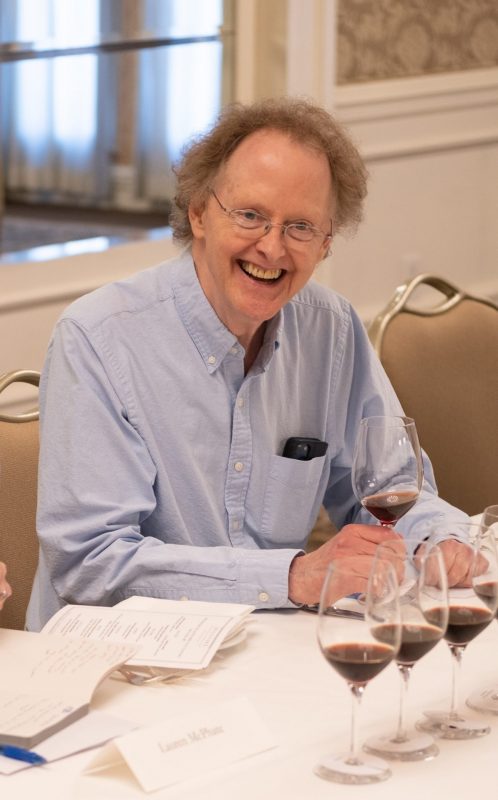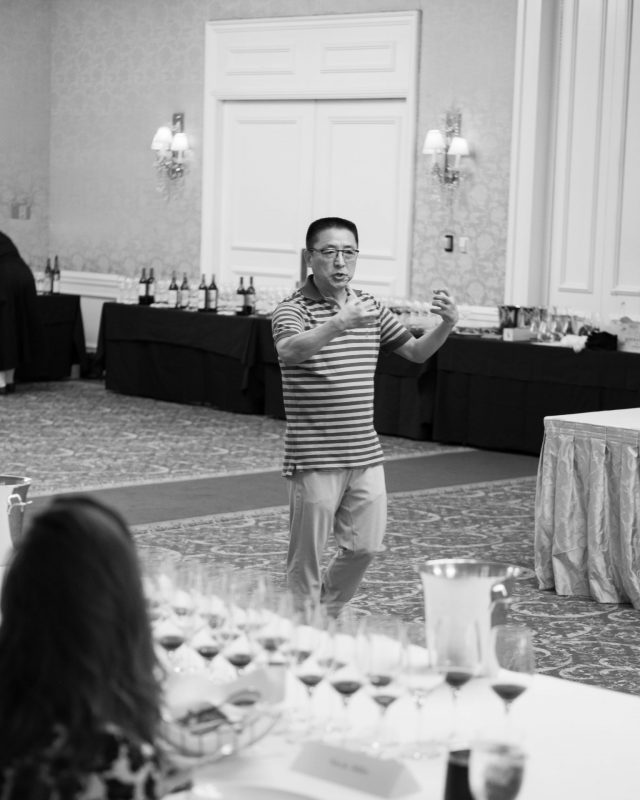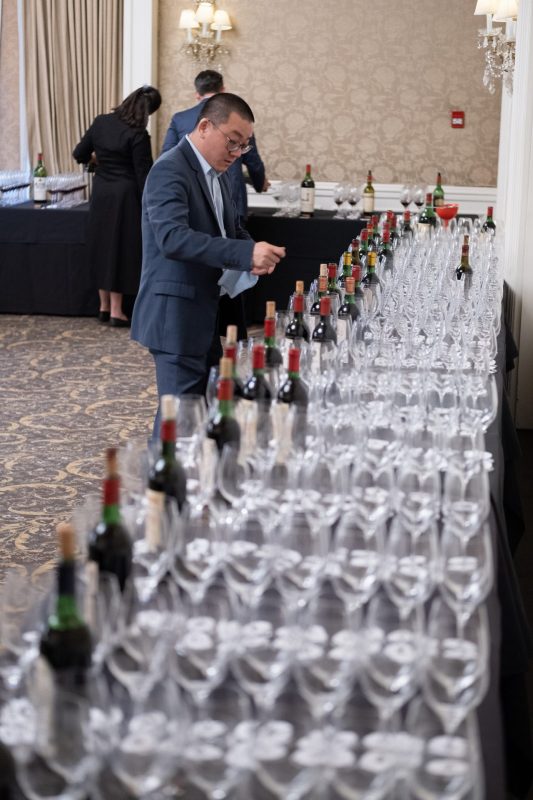Bordeaux 1982 – 40 Over 40
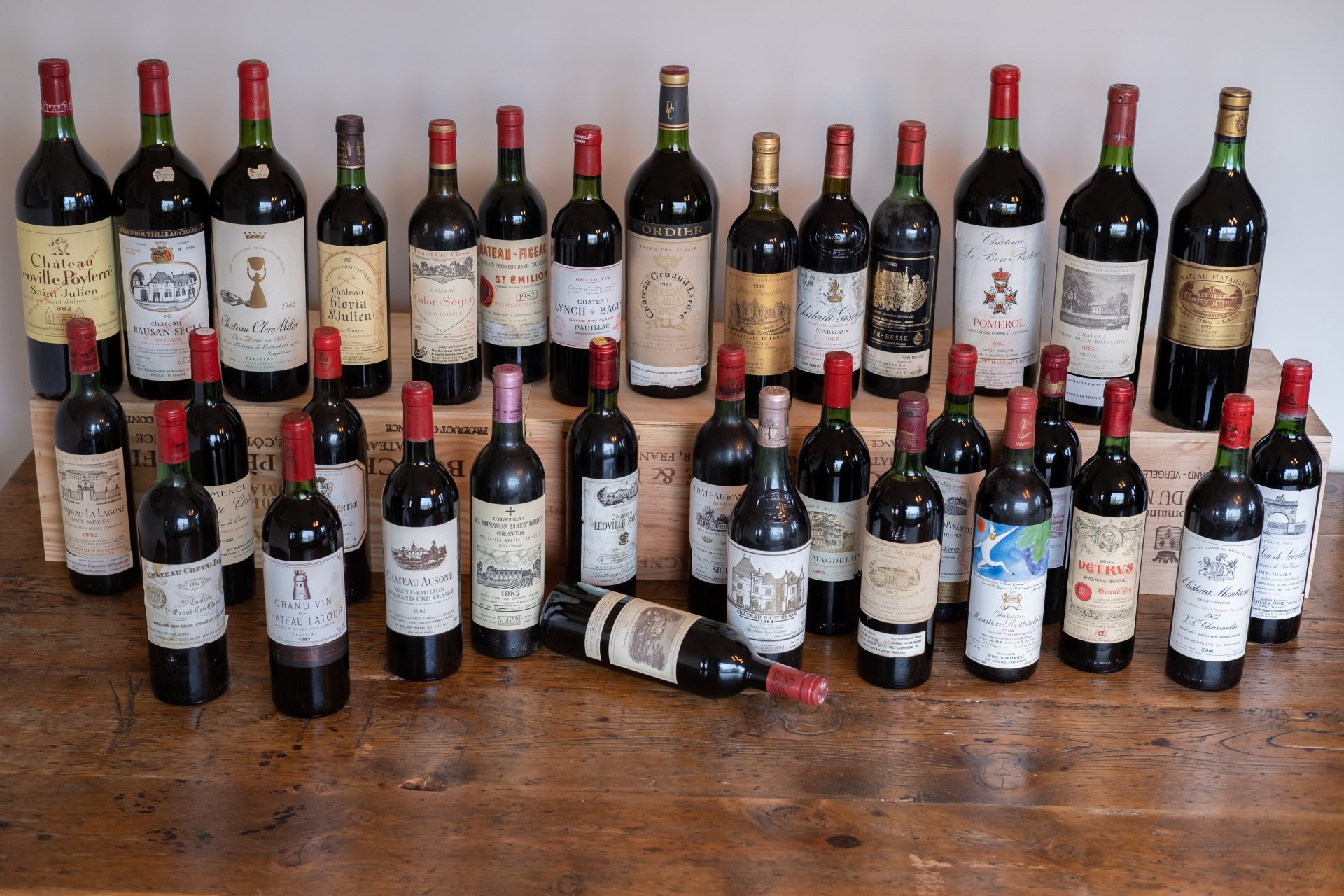
“I have always loved the 1982 Bordeaux,” declares James KiIlam. An avid wine collector for over four decades, he is kicking off a tasting featuring 45 wines from this legendary vintage. The purpose of the dinner, held this past May, was to raise funds for cancer research. Most of the wines hailed from his own personal collection.
“My son was born in 1983 but conceived in 1982,” he continues. “As 1983 was a lesser vintage, I stocked up on 1982 instead.” Apart from the First Growths, most of the wines cost C$10-15 at the time. “The good news for my wife and I was that our son didn’t like wine. So, we drank lots of 1982.”
One of the attributes he extols is the modest level of alcohol. The warm 1982 vintage is feted for its perfect growing conditions, giving wines with ripe flavours and tannins. Yet wondrously, several labels claim an ABV in the 11-12% range. Today’s Bordeaux easily push 14%.
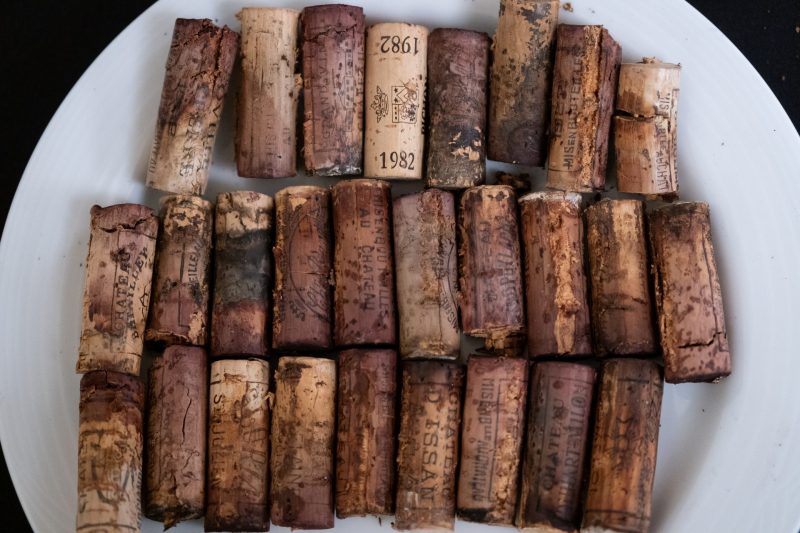
Tasting the wines, I couldn’t help but consider the landscape in the early ‘80s. They were different times – not just climatically but also in terms of viticulture, vinification and business. Most châteaux were still family owned, with limited funds and less technology than we see today. Yields also tended to be higher, with less selection and fewer second wines. A renaissance had just begun, and some properties were working with younger vines due to replanting. Still, the quality is exceptional. “You won’t see wines like this again,” Killam emphasized.
At 41-years-old, the wines were in great shape – a testament to the charisma and tenacity of the vintage. Besides impressive examples from the region’s most distinguished growths, humbler appellations and châteaux exhibited charm and longevity. Admittedly, a handful disappointed, especially when expectations were high. Pétrus fell short of living up to its lofty reputation. I was also let down by Figeac, Léoville Barton and Léoville Poyferré, all three of which I have much affection for. Conversely, Gloria and Sociando-Mallet were out of their league on paper, yet they more than held their own.
To be fair, at this age, an assessment refers to the specific bottle – not the wine in general. For instance, I’d been fortunate enough to enjoy a glass of 1982 Gruaud-Larose a few weeks prior. It was much more animated and seductive than the bottle we opened at this dinner. Furthermore, large formats have an advantage, and unsurprisingly most of those from magnum showed very well, particularly Duhart-Milon, Rauzan-Ségla, Batailley and Clerc-Milon.
There is no doubt that the 1982 Bordeaux are definitely ready to drink. And in this tasting, the bottles of Giscours, d’Angludet, d’Issan and Bon Pasteur had progressed past their prime. However, most still possessed plenty of life and conferred great pleasure. None need further ageing, with perhaps one glorious exception. ‘Dear Latour, when will you be ready?’ read my note. This vied with Lafite for wine of the night. Pichon-Lalande and Léoville-las-Cases were very close behind.
For further musings, below is a snapshot of my top three picks from each of the five fights.
*This dinner raised C$100,000 for The Sullivan Urology Foundation of which 100% of the funds will go to supporting ongoing cancer research of Dr. Yuzhuo (YZ) Wang.

James Killam 
Dr. YZ Wang explaining his cancer research 
Volunteer sommelier Bryant Mao
Flight One – The Warm-up
There were several pleasant surprises among the underdogs, as one of the guests called them. Of course, these benefited by coming before the more glorified châteaux.
Château Gloria, Saint-Julien AOC
I would have never expected this to age so well. While it may no longer be in the absolute prime of its life, the 1982 Gloria still has plenty of charm, bounce and energy. Appealing aromas of cedar and tobacco are steady and persistent. On the palate, baked fruit melds deliciously with caramelized pastry. Very soft with barely-there tannins but still holding together nicely. In the world of Bordeaux, contemporary vintages represent ‘good value’ at approximately $100.
Château Duhart-Milon, Pauillac AOC (from magnum)
While Duhart-Milon was purchased by the Rothschild family in 1962, it certainly wasn’t in its heyday by 1982. The vines had been replanted not long before so were relatively young at the time. An attractive nose with earthy forest and cigar taking on a savoury, saline, even soy edge. Still quite securely structured, this cleanses the palate and stimulates the appetite with citrusy acidity and refined tannins. Good depth and going strong.
Château Sociando-Mallet, Haut-Médoc AOC
A ‘mere’ Cru Bourgeois, Sociando-Mallet is considered equivalent to a Fifth Growth. It is often uncompromising and compact in its youth – sometimes with a touch of pyrazine, but this can make for a compelling evolution. Here, the colour is still bright with a deep ruby core. Aromas of coffee melt harmoniously into sweet spice, cedar and a distinct green herbal twist. Somewhat angular with firm rustic tannins and a steeliness of acidity. Mocha notes repeat and there is a brilliant pop of black currant on the lingering finish. This isn’t going to get any better, but it certainly won’t fade anytime soon.
Flight Two – Classics
Tasting through some of the Left Bank’s classic classified growths, it was gratifying to find the identity of each appellation clearly on display. Pauillac was unsurprisingly solid and thriving, but Margaux and Saint-Julien were equally compelling.
Château Clerc Milon, Pauillac AOC (from magnum)
Admittedly, Clerc Milon isn’t usually my favourite Bordeaux. I can admire it for being well made, but it never seems to thrill me. Yet this is one I kept coming back to. Taking time to open, aromas of espresso and black currant eventually emerge. The palate is firm, linear and muscular with minerally stones and graphite. Persistent and lingering.
Château Rauzan-Ségla, Margaux AOC (from magnum)
Very pure, pretty and fragrant, this exudes dark red berry, iodine, earthy mushroom and then potpourri. Not forceful but attractive. The palate is dark fruited with a vibrant core – more acid than tannins. It has minerals, metal and lots of life.
Château Beychevelle, Saint-Julien AOC
Apparently, Beychevelle’s winemaking team made no selection in 1982, meaning 95% of production went into this Grand Vin. It smells fantastic from the get-go – evocative deep forest and dark earth with touches of leather and old spice box. Every element is so well-integrated as it traverses the palate. Flavours of dried currants are spiked with gravelly and salty minerals. Very tangy and satisfying. Lots to chew on here.
Flight Three – ‘Super Seconds’
Besides a badly corked Cos d’Estournel and a disappointing duo from beloved Léoville Barton and Poyferré, the rest of this 10-wine flight was strong. While Léoville-las-Cases and Pichon-Lalande stood out above all, picking a third favourite was like splitting hairs. The velvety Ducru Beaucaillou? The tertiary yet hauntingly soulful Montrose? I settled on Palmer…
Cháteau Léoville-las-Cases, Saint Julien AOC
One of the most ‘youthful’ in expression, yet all very understated and discreet at first. Cedar tinged in bouquet with blackberries freshly picked from the bush. More savoury than fruit-led but pure and pristine, the palate builds with confident, brilliantly formed, long, velvety tannins to a sneaky powerful finish. I can only imagine that this will still be just as elegant in 10 years.
Château Pichon Longueville Comtesse de Lalande, Pauillac AOC
What an absolute stunner! Aromas are exotic and expansive, a heady mix of spice and truffles. Assertive in backbone, fleshy in substance and sensuous in mouthfeel. Minerally and lead pencil on the one hand with dark bramble berry plushness on the other. Drinking beautifully now, and still plenty to give.
Château Palmer, Margaux AOC
At a dinner in 2016 with Jean-Louis Carbonnier, Château Palmer’s North American ambassador, he reminded me that 1983 was actually considered a better vintage than 1982 in Margaux. I haven’t tried the 1983 but it is difficult to imagine anything better than this 1982. Striking and glamourous, the nose offers an exuberant and expressive mix of mint, eucalyptus, tobacco, dried leaves, cigar box and exotic spice. There is a seductive seamless to the palate with pliable yet taut tannins embracing the black plum core. Persistent and precise.
Flight Four – The Right Bank
This flight took us through some of the most famous châteaux of the Right Bank. Think Pétrus as well as the most expensive wine of the tasting – Château Lafleur at an estimated $9000 for a 750ml bottle. As impressive as it was in its density, ripeness and flamboyance, this was not the wine I wanted a glass of. Instead…
Château Ausone, Saint-Emilion 1er Grand Cru Classé AOC
Although Ausone wasn’t the star of the tasting or the flight (that honour goes to the Cheval Blanc), this bottle was in much better shape than the one I tried nine years ago. Ethereal perfumed scents (thank you Cabernet Franc) of pressed flower, wet earth and tar. Very pretty with supple tannins, red plum hint and minerally sensation on palate. Chalky finish dissolves quickly but this is still quite delightful.
Château Cheval Blanc, Saint-Emilion 1er Grand Cru Classé AOC
It is impossible to forget the heady scents emanating from a double magnum I decanted in 2005. It was my first time tasting 1982 Cheval Blanc and still one of the most profound wine experiences of my life. NO subsequent bottle will ever be able to top that. However, this one was showing MUCH better than the one we had at a similar fundraiser in 2014. It demonstrated all its exotic charms with remarkable vitality. From a bouquet of peppermint, eucalyptus and wet clay, the palate progresses to fleshy plum and cherry laced with chocolate. Sumptuous and enveloping with waves of plush layers and all that perfume coming through. This is as long and supple as it is thought provoking.
Château La Conseillante, Pomerol AOC
I was totally captivated by the evocative nose redolent of stone, eucalyptus and terracotta. Juicy and sumptuous, the palate is perfumed with purple flowers and licorice. Soft caressing tannins hem in a core of cherry and plum. This trails off slowly with smoky incense. Gracefully seductive.
Flight Five – Left Bank First Growths
This final flight included La Mission Haut Brion which outperformed both Haut Brion and Margaux. It deserves a spot here with the impressive Pauillac trio. All but a donated bottle of Margaux were purchased by James upon release for an estimated C$40-50. What an investment! And no better way to cash in on it.
Château La Mission Haut Brion, Graves AOC
Wonderous depth of tea, tobacco, clove and smoke aromas. These repeat on palate lacing in with stony minerals and red brambly berries. So well sculpted and finely etched. The finish is firm and focused. This is in no danger of declining anytime soon.
Château Mouton-Rothschild, Pauillac AOC
Mouton-Rothschild was drinking à point in 2014. It still is today. While perhaps less flashy, it is still gorgeously pure fruited and expressive, and seems to defy its 40-plus years of age. Mint, cedary forest and cigar infuse dark, rich, concentrated berries. Sumptuous tannins wrap around the palate with gracious ease. Really quite complete and comfortable in its complex, enveloping and opulent skin.
Château Latour, Pauillac AOC
Latour’s arresting 1982 Grand Vin allies power with grace and density with agility. It is an effortless convergence of dark spiced berries and earthy cedar forest with savoury leather and tar. Confident without being arrogant, this possesses nerves of steel, a measured stride and a munificent heart. Tannins are masterful, still wielding a tight grip. Poised to be the wine that will outlive all its peers. Another 10 to 15 years is not out of the question.
Château Lafite-Rothschild, Pauillac AOC
Simply stunning from start to finish, Lafite unfolds leisurely building with perfumes of tobacco, cherry, graphite, flint and smoke. The palate is beautifully weighted expanding delicately but assuredly and gratifying ever part of the mouth. It seems to float. Succulent minerals accent the forest berry core. Tannins are sophisticated enfolding the finish where a burst of currants and dried bay laurel linger. This is all yin to Latour’s yang and drinking so perfectly right now.

